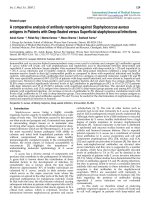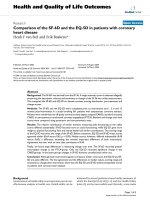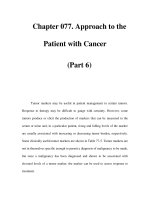Chapter 082. Infections in Patients with Cancer (Part 3) pdf
Bạn đang xem bản rút gọn của tài liệu. Xem và tải ngay bản đầy đủ của tài liệu tại đây (47.75 KB, 5 trang )
Chapter 082. Infections in
Patients with Cancer
(Part 3)
The level of suspicion of infections with certain organisms should depend
on the type of cancer diagnosed (Table 82-3). Diagnosis of multiple myeloma or
CLL should alert the clinician to the possibility of hypogammaglobulinemia.
While immunoglobulin replacement therapy can be effective, in most cases
prophylactic antibiotics are a cheaper, more convenient method of eliminating
bacterial infections in CLL patients with hypogammaglobulinemia. Patients with
acute lymphocytic leukemia (ALL), patients with non-Hodgkin's lymphoma, and
all cancer patients treated with high-dose glucocorticoids (or glucocorticoid-
containing chemotherapy regimens) should receive antibiotic prophylaxis for
Pneumocystis infection (Table 82-3) for the duration of their chemotherapy. In
addition to exhibiting susceptibility to certain infectious organisms, patients with
cancer are likely to manifest their infections in characteristic ways.
Table 82-3 Infections Associated with Specific Types of Cancer
Cancer
Underlying Immune
Abnormality
Organisms
Causing Infection
Multiple
myeloma
Hypogammaglobulinemia Streptococcus
pneumoniae
,
Haemophilus
influenzae,
Neisseria
meningitidis
Chronic
lymphocytic
leukemia
Hypogammaglobulinemia S. pneumoniae,
H.
influenzae,
N.
meningitidis
Acute
Granulocytopenia, skin and
Extracellular gram-
myelocytic or
lymphocytic
leukemia
mucous-membrane lesions positive and gram-
negative bacteria, fungi
Hodgkin's
disease
Abnormal T cell function Intracellular
pathogens
(Mycobacterium
tuberculosis, Listeria
,
Salmonella, Cryptococcus
,
Mycobacterium avium
)
Non-
Hodgkin's
lymphoma and
acute lymphocytic
leukemia
Glucocorticoid
chemotherapy, T and B cell
dysfunction
Pneumocystis
Colon and
rectal tumors
Local abnormalities
a
Streptococcus bovis
(bacteremia)
Hairy cell
leukemia
Abnormal T cell function Intracellular
pathogens (
M.
tuberculosis, Listeria
,
Cryptococcus, M. avium)
a
The reason for this association is not well defined.
System-Specific Syndromes
Skin-Specific Syndromes
Skin lesions are common in cancer patients, and the appearance of these
lesions may permit the diagnosis of systemic bacterial or fungal infection. While
cellulitis caused by skin organisms such as Streptococcus or Staphylococcus is
common, neutropenic patients—i.e., those with <500 functional
polymorphonuclear leukocytes (PMNs)/µ L—and patients with impaired blood or
lymphatic drainage may develop infections with unusual organisms. Innocent-
looking macules or papules may be the first sign of bacterial or fungal sepsis in
immunocompromised patients (Fig. 82-1). In the neutropenic host, a macule
progresses rapidly to ecthyma gangrenosum, a usually painless, round, necrotic
lesion consisting of a central black or gray-black eschar with surrounding
erythema. Ecthyma gangrenosum, which is located in nonpressure areas (as
distinguished from necrotic lesions associated with lack of circulation), is often
associated with Pseudomonas aeruginosa bacteremia (Chap. 145) but may be
caused by other bacteria.









